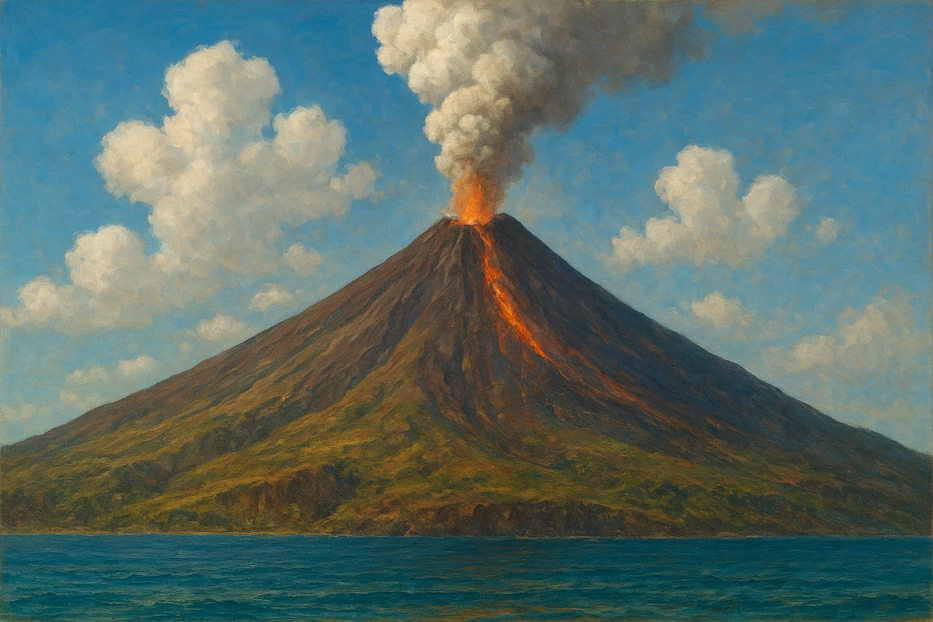Europe is full of breathtaking landscapes, but few are as dramatic and unforgettable as its volcanic islands.
From towering calderas plunging into the turquoise sea to black-sand beaches, steaming fumaroles, and centuries-old thermal springs, these islands are living monuments of Earth’s power. Every corner tells a story shaped by fire, water, and human resilience.
Note: The Canary Islands, like La Palma or Tenerife, are politically part of Spain but geographically in Africa. This guide focuses exclusively on volcanic islands that are both geographically and culturally European.
Table of Contents
Santorini, Greece — The Caldera of Dreams
No list of European volcanic islands would be complete without Santorini. The island’s cliffs rise dramatically from the Aegean Sea, a legacy of a massive eruption around 1600 BC that created the famous caldera. Walking the narrow cobbled streets of Fira and Oia, visitors feel suspended between sky and sea. Whitewashed houses cling to cliffs, blue-domed churches gleam in the sun, and terraces host vineyards thriving in volcanic soil.
Santorini’s volcanic heart continues to pulse in the caldera’s center, where Nea Kameni and Palea Kameni steam gently. Adventurous travelers can hike up volcanic slopes and bathe in mineral-rich hot springs, enjoying waters warmed by the Earth itself. At sunset, Oia becomes a canvas of pinks and oranges reflecting off volcanic cliffs, a sight where geology and romance merge perfectly.
Stromboli, Italy — Europe’s Eternal Fireworks
Stromboli is one of Europe’s most active volcanic islands, erupting almost continuously for two thousand years. At night, fiery fountains of lava light up the Mediterranean sky, creating a spectacle that feels like standing on the edge of the world. Hiking Stromboli is an unforgettable experience: the crunch of volcanic gravel underfoot, the sulfur-scented air, and the occasional deep rumble remind visitors that the Earth beneath them is alive.
By day, the island softens. Tiny villages with whitewashed houses, terraced lemon groves, and quiet harbors contrast the nightly fireworks. Black-sand beaches formed by cooled lava invite relaxation, while local tavernas serve freshly caught seafood alongside wines grown in volcanic soil. Stromboli perfectly combines raw geological power with Mediterranean charm.
Vulcano & Lipari, Italy — The Islands That Named “Volcano”
Vulcano, the island that gave its name to the word “volcano,” is a place where Earth’s power is palpable. Hikers ascend the Gran Cratere to witness steaming fumaroles, feeling the heat from molten depths. Natural mud pools and thermal baths offer rejuvenation, a reminder that volcanic islands can be both awe-inspiring and soothing.
Nearby Lipari balances raw volcanic landscapes with Mediterranean charm. Its lush terraces, pumice beaches, and lively harbors showcase centuries of human adaptation to volcanic soil. From obsidian artifacts preserved in local museums to secluded coves perfect for swimming, Lipari demonstrates the harmony between humans and fire-born landscapes.
Ischia, Italy — Thermal Paradise
Ischia, just off Naples, is a verdant volcanic haven. Mount Epomeo rises above vineyards, villages, and forests, offering sweeping views of the Tyrrhenian Sea. The island’s thermal gardens, such as Poseidon and Negombo, provide mineral-rich pools fed by geothermal activity.
Walking along the coast, visitors find black sand beaches, jagged lava formations, and natural warm pools where volcanic heat meets the sea. On Ischia, the volcano’s presence is felt not in eruptions but in the gentle warmth of centuries-old thermal waters, blending nature, comfort, and relaxation in a way few other European islands can match.
The Azores, Portugal — Atlantic Volcanic Eden
The Azores archipelago, in the middle of the Atlantic, is Europe’s volcanic secret. Each of the nine islands presents a living geological exhibit: massive calderas, crater lakes, steaming fumaroles, and black sand beaches.
São Miguel captivates with the twin lakes of Sete Cidades, formed in a collapsed crater, and the bubbling geothermal pools of Furnas, where traditional stews cook underground in volcanic heat. Pico Island, dominated by Portugal’s highest peak, challenges climbers to ascend volcanic slopes and explore UNESCO-listed lava vineyards. Faial Island tells a story of recent eruption: Capelinhos in 1957 added new land almost overnight, leaving a lunar landscape that contrasts with the lush greenery.
Heimaey, Iceland — The Island That Survived Fire
Heimaey, the largest of Iceland’s Vestmannaeyjar islands, is a living lesson in resilience. In 1973, the Eldfell volcano erupted without warning, forcing the entire population to evacuate. Months later, the islanders returned, diverting lava flows and rebuilding their homes. Today, cooled lava fields coexist with thriving communities and puffin colonies along rugged coastlines.
Hiking Eldfell provides dramatic panoramas over the volcanic scars and the new coastline, while Eldheimar Museum preserves the eruption’s story. Here, visitors feel both awe at Earth’s power and respect for human resilience.
Pantelleria, Italy — Hidden Gem of Fire and Wind
Pantelleria lies quietly between Sicily and Tunisia, a volcanic island sculpted by wind, sea, and fire. Its crater lakes, steaming fumaroles, and rugged interior invite adventurous travelers to explore off-the-beaten-path landscapes. Specchio di Venere, a volcanic crater lake, mirrors the sky, while nearby thermal caves act as natural saunas heated from beneath.
Pantelleria’s famed Passito wine grows in terraces trained low against strong winds — a human adaptation to volcanic soil. Hiking Montagna Grande or exploring the lava-shaped coastlines, visitors experience an intimate and untamed volcanic world unlike anywhere else in Europe.
Nisyros, Greece — Step Inside a Volcano
Nisyros, off Kos in the Dodecanese, is small but extraordinary. Visitors can walk directly into the active Stefanos Crater, where bubbling fumaroles and sulfur vents remind you the island is alive. The scent of sulfur, the rising steam, and jagged volcanic terrain create a tactile, unforgettable experience.
Beyond the crater, whitewashed villages cling to slopes, offering Greek charm alongside thermal springs. Walking trails and the local volcanic museum provide both adventure and insight into this island’s fiery history. Nisyros proves that some European volcanic islands are not just scenic wonders but immersive geological experiences.

